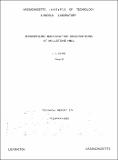Ionospheric Backscatter Observations at Millstone Hill
Author(s)
Evans, J. V.
DownloadTR_374.pdf (2.372Mb)
Metadata
Show full item recordAbstract
Studies of the electron-density, eIectron and ion temperatures in the F-region were mode by means of ground-based radar observations at the MilIstone Hill Radar Observatory. A 70-meter parabolic antenna directed vertically and a 2.5-Mw pulse radar operating at 440 Mcps were employed for these measurements which were conducted for periods of 30 hours at approximately weekly intervals throughout 1963. Examination of the echo power as a function of height leads to a profile of electron density with height, provided the electron and ion temperatures are the same (T[subscript e] = T[subscript i]). Additional measurements of the spectra of the signals corresponding to different heights permit the ratio T[subscript e]/T[subscript i] to be determined and, where this is different from unity, the observed profile can then be corrected for the effect on the scattering introduced by the inequality in temperature.
Results of observations extending over a period of one year from February 1963 to January 1964 are presented. The ratio T[subscript e]/T[subscript i] achieved a maximum value ~2.0 to 2.6 at a height of about 300 km soon after dawn, irrespective of the season. There was Iittle change in height dependence in this ratio throughout the daylight hours, and at sunset the ratio felI with a time constant of the order of an hour. At night T[subscript e]/T[subscript i] was occasionally close to unity, but more often a significant difference remained in the temperatures at all heights. Ion temperature increased with height at all times, but above 500 km this may be due in part to the presence of an unknown amount of He[superscript +] ions, which considerably affects the interpretation of the signal spectra. Electron temperatures were largely independent of height above about 300 km. Evidence is presented of ionospheric heating during magnetically disturbed conditions, but it is shown that this is only of great importance at night.
Date issued
1965-01-22Publisher
Haystack Observatory
Series/Report no.
Millstone Technical Reports;374